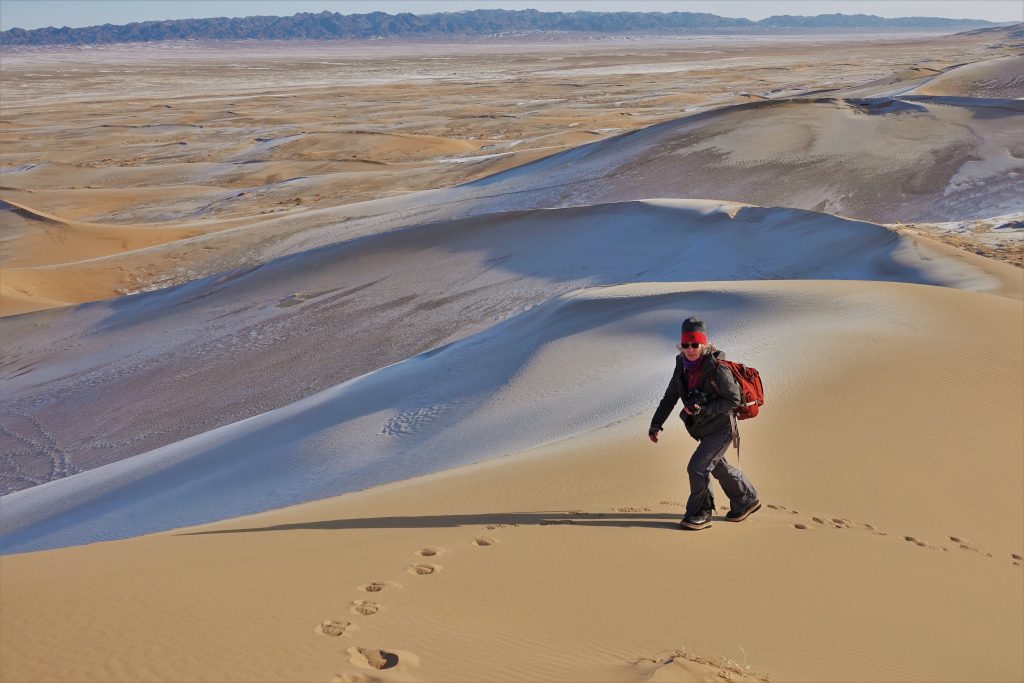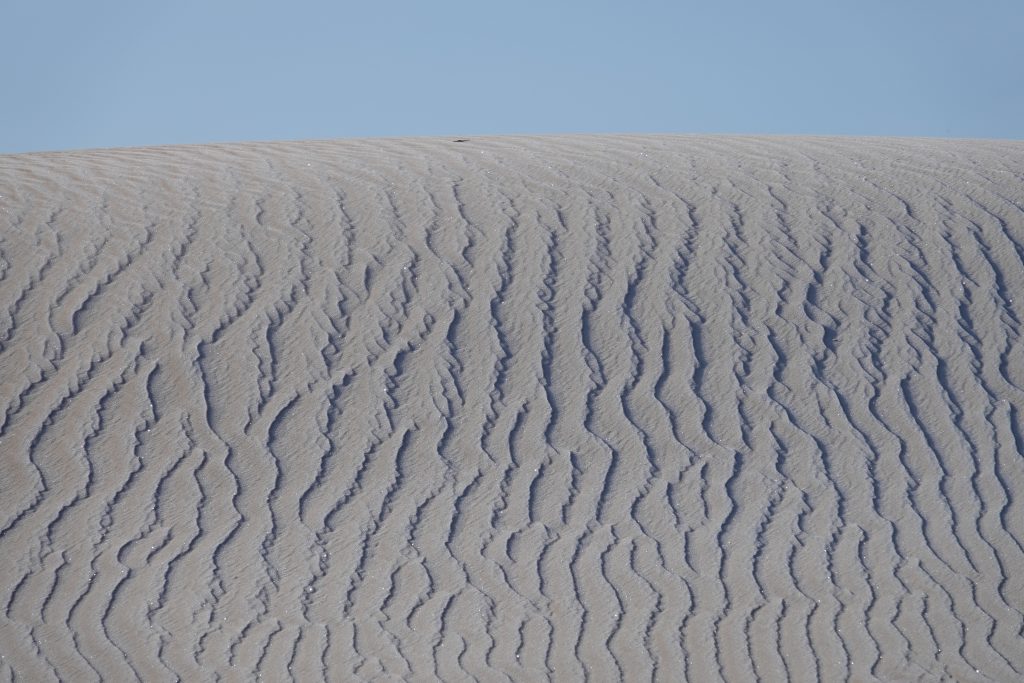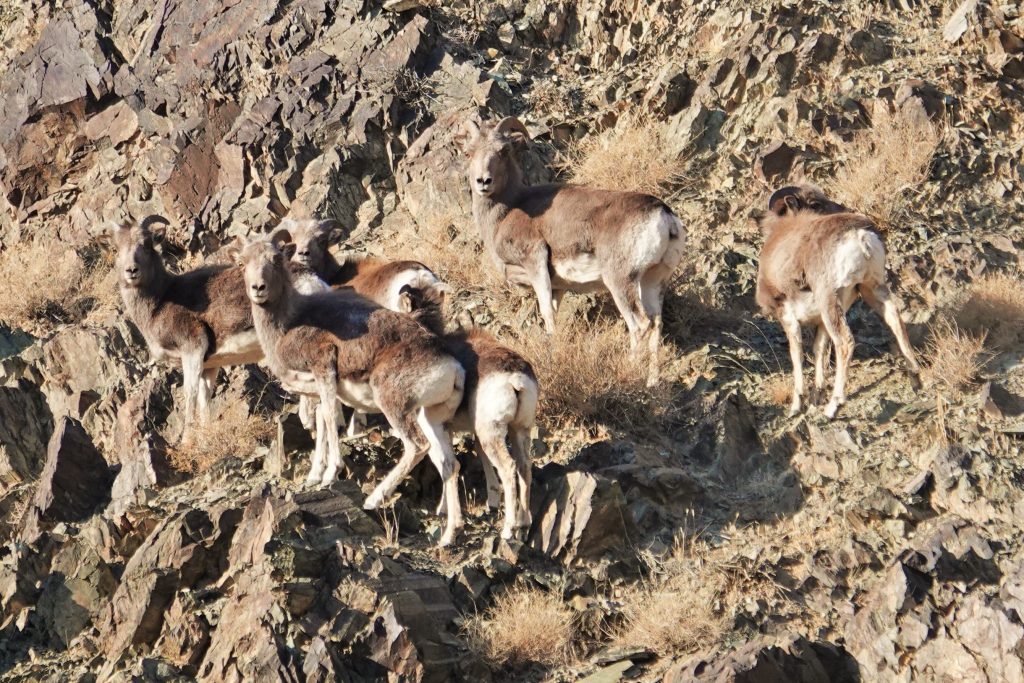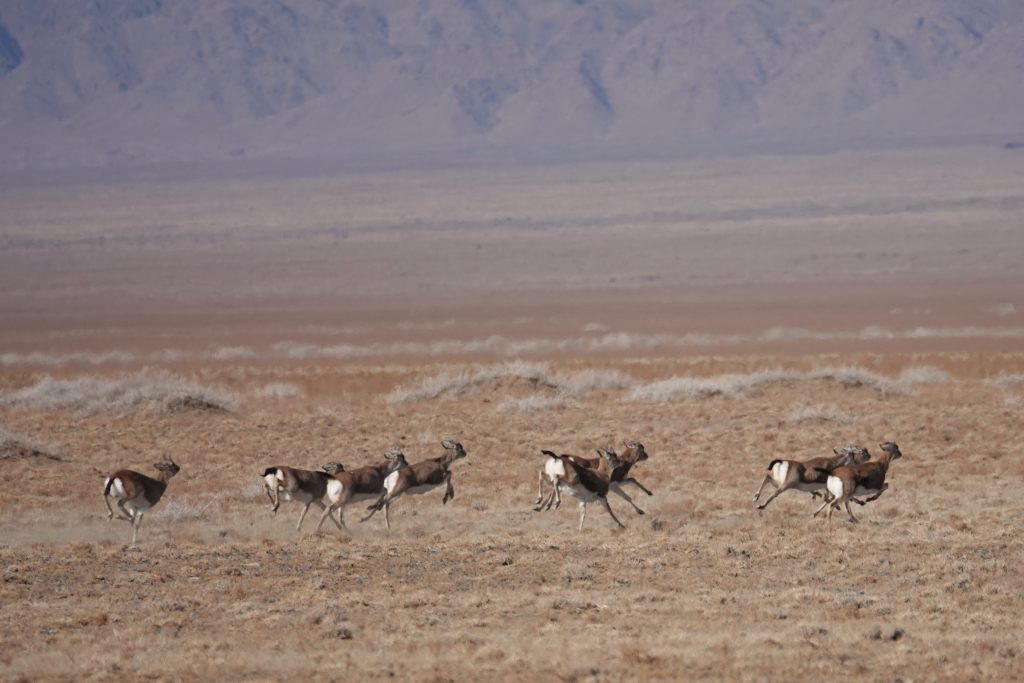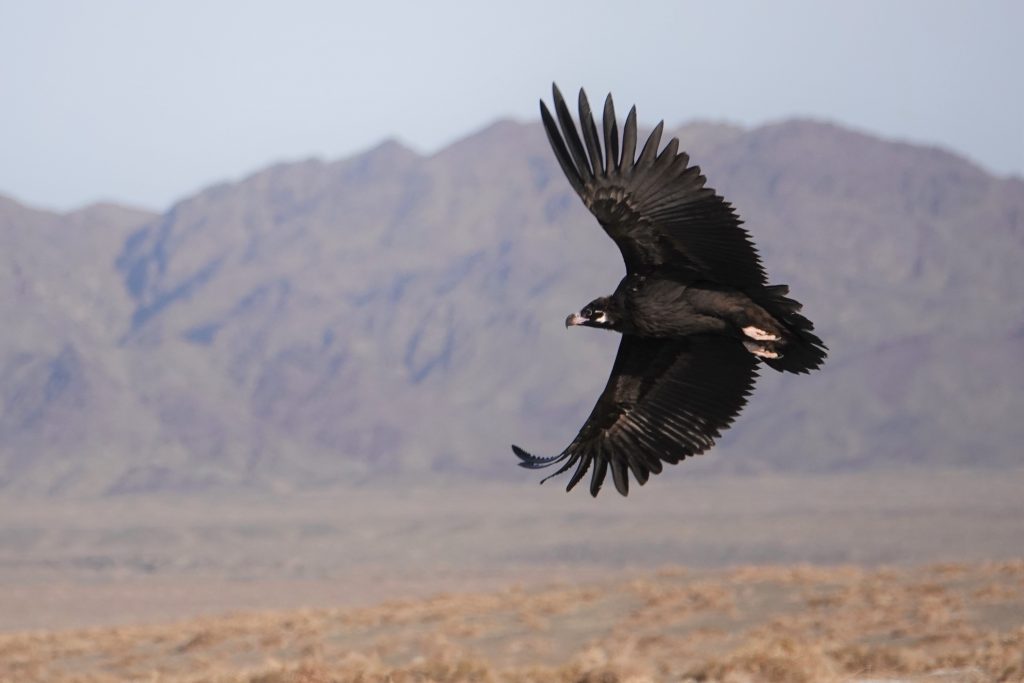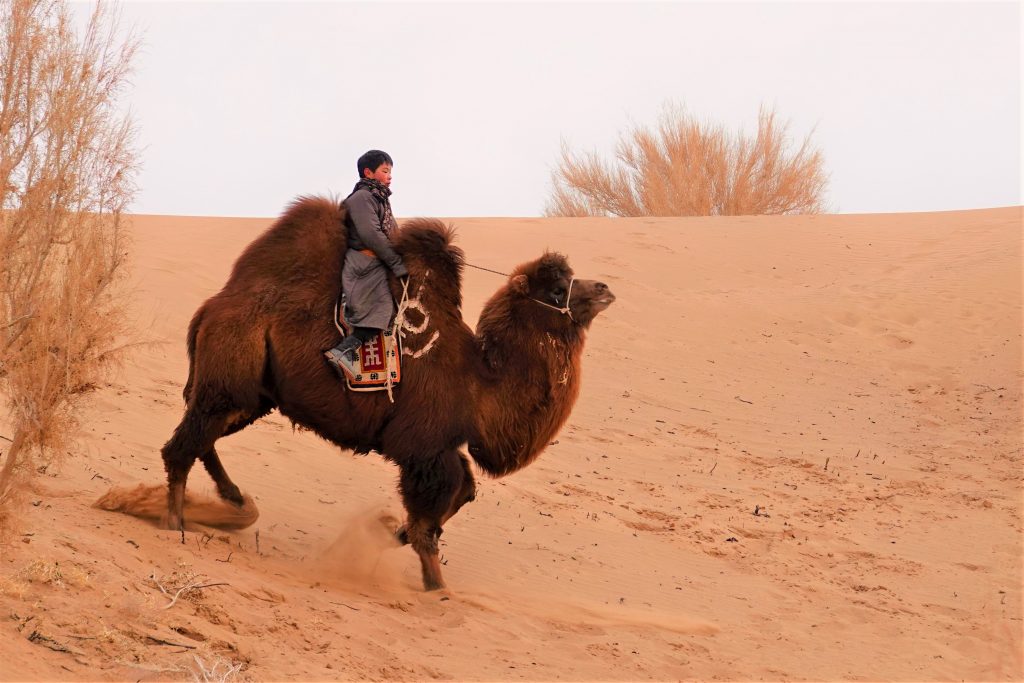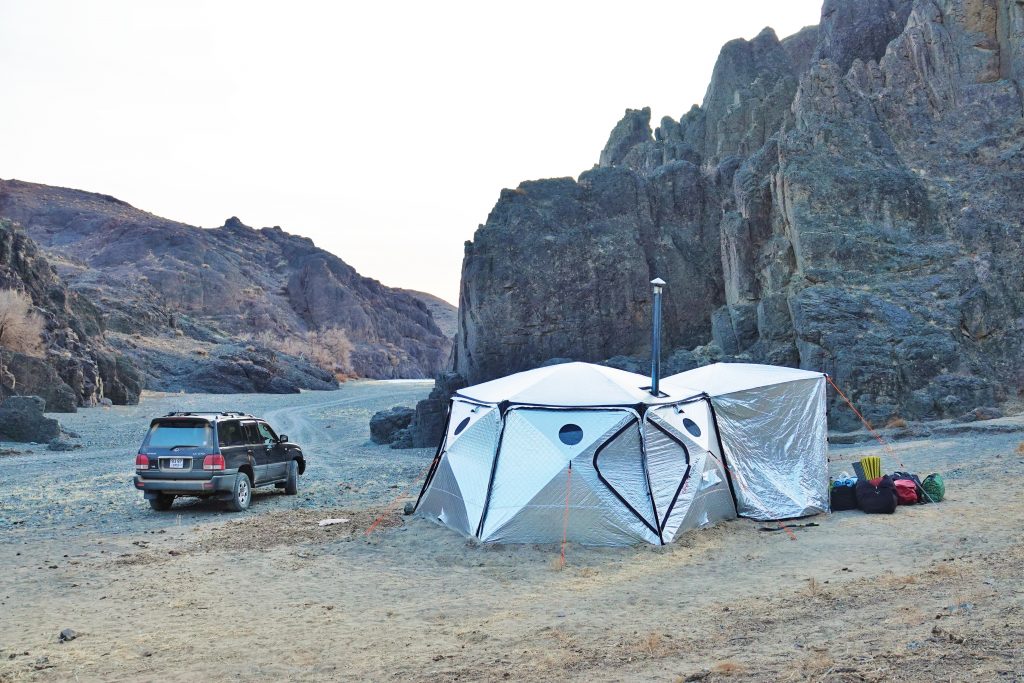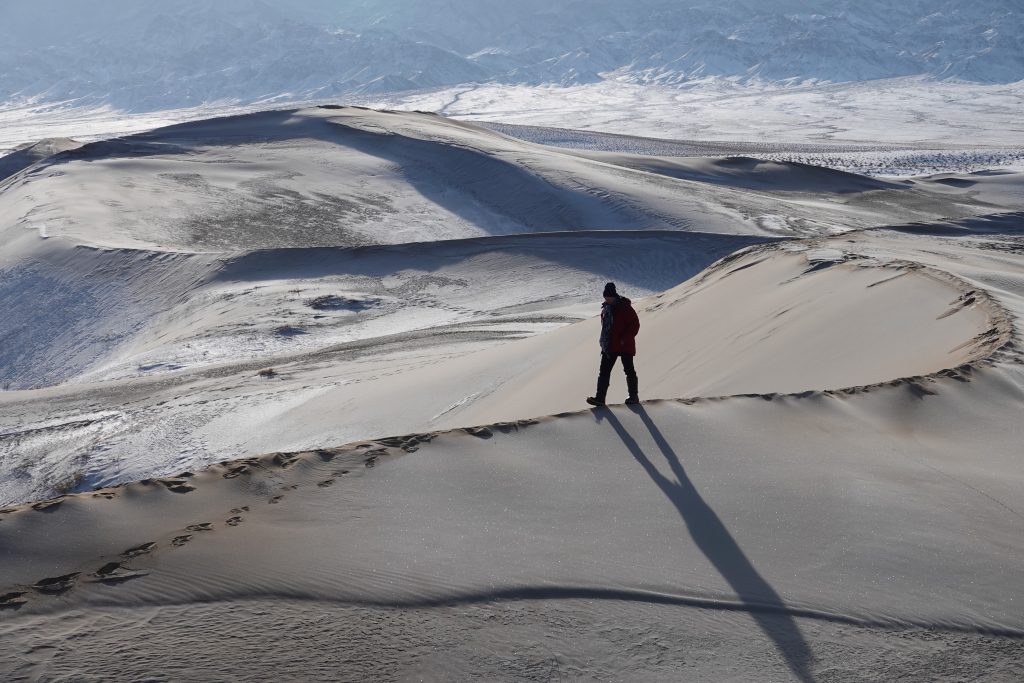No products in the cart.
Winter Camping in Mongolia’s Gobi
Custom Tour for Your Private Group – Contact us to design your Adventure
A Place and Time for True Adventure Travelers
A desert with temperature extremes and among the coldest deserts on earth, the Gobi is probably not the preferred destination for most people planning a vacation. But if you are drawn to vast landscapes, fascinated by nomadic cultures, and interested in wildlife encounters, think of travel in the Gobi. If you really want to get away, from crowds, from light pollution, and from your routine, then the Gobi might be for you.
Mongolia is among the least populated countries in the world, with an average population density of two people per square kilometer. In its arid Southern expanses, where camels still are an important mode of transportation for nomadic livestock herders, it is less than that. And in winter, it is even more extreme. The camps for tourists are closed, the famed locations like the Flaming Cliffs and Singing Sands are devoid of visitors. This is the time for true adventure travelers to explore the Gobi.
Staying Warm and Safe in the Winter Desert – Local Knowledge and a High Tech Shelter
We set out in the coldest time of the year, in early January, to experience the winter desert. While the Gobi, in the Southern region of Mongolia, is not as cold as the country’s North where winter temperatures drop to below – 40 F, or more at times, a Gobi winter tour is still a cold weather adventure. Our night time temperatures reached nearly – 10 F. Day times however were relatively mild, even above freezing sometimes, pleasant for hikes and short climbs. With no wind and a strong sun, we enjoyed picnic lunches in the big open spaces, watching herds of gazelle grazing on the plains in the distance.
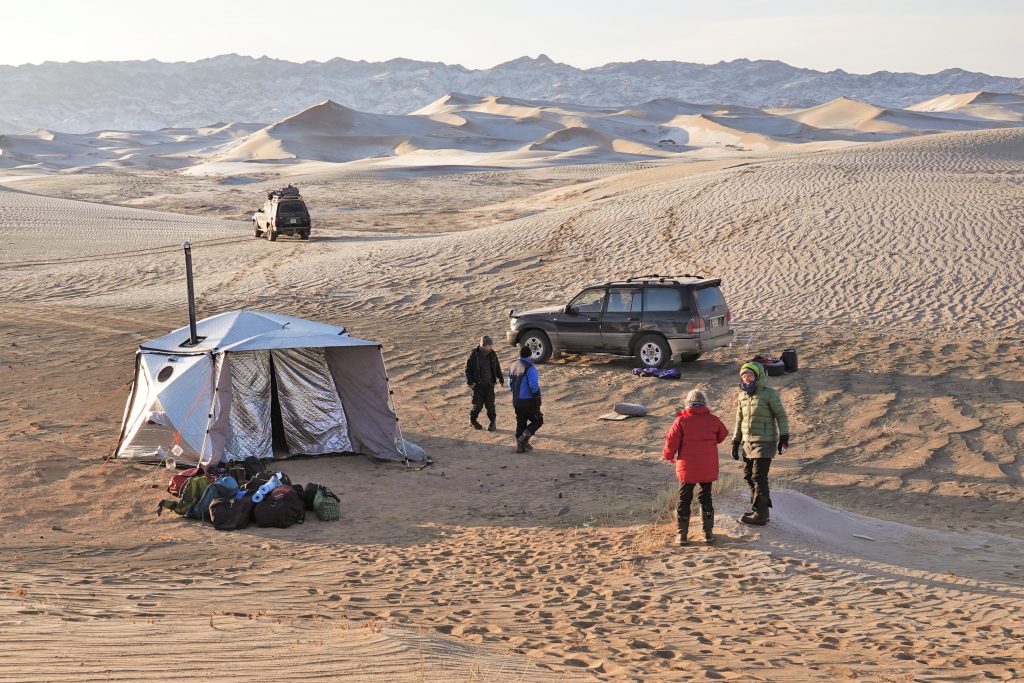 Our nights were spent in our own special shelter, set up at scenic sites where our senses were exposed to the grandeur of the Gobi landscapes. The first location was in a gorge, on a small grass plateau well above the valley floor, amidst rugged cliffs through which the canyon winds. Nearby was a well to where camel herds would come for watering in the evenings. Gnarly desert elm grow on the edges of the canyon, their lower trunks engulfed by rushing water when summertime flash foods race through.
Our nights were spent in our own special shelter, set up at scenic sites where our senses were exposed to the grandeur of the Gobi landscapes. The first location was in a gorge, on a small grass plateau well above the valley floor, amidst rugged cliffs through which the canyon winds. Nearby was a well to where camel herds would come for watering in the evenings. Gnarly desert elm grow on the edges of the canyon, their lower trunks engulfed by rushing water when summertime flash foods race through.
From here we explored side canyons on foot, and traveled further South into the desert plains, to wooded areas with shrub land where camels were grazing, and to the flats of a frozen salt lake where snow and salt crusts mixed to make white sculptures.
Our camp would go up in minutes, and this included the installation of a wood stove which we would keep going all night with pressed fuel of high caloric value while burning with low smoke emission. Our shelter is a “shiftpod”. Developed as well insulated tent for the “Burning Man” festival against the heat of the Black Rock Desert of northwest Nevada, it’s a great structure in both hot and cold conditions.
It gave us warmth, space and peace of mind, knowing that it also is very resistant against high winds. Though winter is the calmest season in the Gobi, camping trip preparations for Mongolia’s South need to be mindful of the possibility of storms year round.
The Mongolian Ger – Ingenious Dwelling for a Nomadic Lifestyle
Through our long-term involvement in Mongolia’s Gobi, working with local communities on the protection of wildlife and natural resources in and around the largest National Park of Mongolia – Gobi Gurvan Saikhan National Park, we are fortunate to have close ties to the people of the Gobi.
Our local driver is as knowledgeable about routes and scenic sites, and about spots to observe wildlife as he is concerned about the preservation of natural and cultural values. He knows the local families of nomadic livestock herders. Stopping by at a ger (yurt) of friends or relatives for milk tea and a chat is a natural routine for him, and there could be no better way for a truly authentic experience of life in the Gobi.
The ger is the traditional felt dwelling that has been in use for millennia across the steppes of East and Central Asia. It is an ingenious construction of collapsible lattice structures as walls. The roof center is a circular wheel from which poles extend to the walls like the spokes from a hub. This creates the tension to make this a very strong structure.
Covered with felt, it is well insulated, cool in summer and warm in winter. Wall covers of patterned textiles and rugs, along with the typical orange ger furniture adorned with colored paintings add to the friendly, warm atmosphere of the Mongolian ger. Traditional hospitality and the care of the hosts especially for foreign guests of course really set the atmosphere.
Desert Art of Sand, Wind, Snow and Frost
Another camp site was at the edge of the Singing Sands, among the lower dunes that seemed like frozen waves now. The site was a great base from which to hike into the sands, and up onto some of the higher peaks. A paradise for photography at any time, the images of the great sands were even more intriguing in the winter season.
Anybody who has ever spent time photographing the textures and shapes of wind shaped sand dunes knows how addicting it gets. Add to this the interplay of sand with snow and the touch-up with frosting on the sandy surfaces, and it becomes even more of a playground for photography, where one forgets the time and the cold when captured by the artworks of sand, wind, snow and frost.
Tracks in the Snow and Winter Wildlife Encounters
Our last camp site was at the Southern entrance of another great gorge that winds through the rugged peaks of one of the major mountain ranges of Gobi Gurvan Saikhan National Park. The park’s name translates into “Three Beauties of the Gobi”, the three beauties being the three mountain ranges at its core.
Having set up our shelter, we set out to explore our surroundings a bit in the last light as the sun had already disappeared below the cliffs across the valley. And soon we would see the tracks in the snow, larger and a few smaller ones, of a large cat, with all the hallmarks of snow leopard tracks like the drag marks of the snow leopards long tail. It looked like their playground, and long marks in the snow also marked a bush as the bathroom of the cats.
On winter travels in the Gobi we have seen tracks of snow leopard quite often, and over many years in Mongolia’s Gobi I have been fortunate to see snow leopard twice. By chance this was, as we do not pursue these precious animals or encourage any activity that may impact their habitat or lifestyle. Just knowing they are there is a beautiful feeling, and to see one is a very special reward.
It is likely however that at some point when traversing the mountain ranges here, the traveler will spot ibex high in the rock walls, or argali sheep on the more gentle mountain slopes. It does take a bit of practice perhaps to make them out against the background, but again, the local drivers are very good at it.
Other wild life species to encounter are the Mongolian gazelle and the rarer goitered, or black tailed gazelle. And in the areas of shallow water bodies, the traveler will come across the flocks of sand grouse, thousands of birds moving like one cloud together. Sometimes, when they are on the ground, one might be quite close to them before realizing at as they blend in well with the desert ground.
Birdlife in the Mongolian Gobi
There is a rich birdlife in this desert. Sightings of the Cinereous vulture are impressive. From the distance one may mistake the large birds, as they sit on the ground, for people. Whenever there is a group of them, some sitting, others flying up or circling high above, they are likely near a source of food, the dead body of a wild or domestic animal that fell prey to wolf or other predators. Foxes might join in and ravens are almost ubiquitous when there is meat to share.
Other large birds are the Upland Buzzard and of course the Bearded Vulture, or Laemmergeier, with its amazing wingspan of nearly three meters. This legendary bird can be seen mostly high in the blue skies. It gave the famed “Vulture Gorge” in the Mongolian Gobi its name. It feeds on bones only, and takes its meals after it has dropped bones from great heights to shatter them on cliffs or rocky ground below.
Nomads of the Gobi – Ancient Traditions and Modern Technology
While many places in this great desert remain untouched, and wildlife is more abundant here than in other parts of the country, the Gobi is mostly a cultural landscape as are the steppes of Mongolia that have been used by live stock herders for millennia. The households of the nomadic families in the Gobi are spread far apart across the desert. With grazing resources more scarce than in the grasslands of the central and northern regions of the country, this is a necessity to provide for the food base of their livestock.
The camel here takes the place of the horse in other parts of the country. It is riding animal for herding, and a means of transport for moving camps. It provides milk, meat and wool. And it is the pride and joy of Gobi nomads, who celebrate camel festivals in spring time to compete and present their best breeding and racing camels.
Traveling in the Gobi is as much a cultural experience as it is a wilderness adventure. While the people here apply their age old skills and knowledge to survive and thrive in one of the harshest environments on the planet, and herd their camels, cows, yak, sheep and goats in the plains and mountains as their forefathers did, they are modern people at the same time, well versed with modern technology. Nearly every family here will have their set of TV, connected to a satellite dish and run by solar power.
In many gers one will see several mobile phones, sometimes dangling high for better reception, with connections to different service providers. If the signal is too weak down here, there is also the trick to throw the phone high in the air… I was once instructed, for sending a phone message, to go to a certain spot, type my message and fling the phone high up as fast as possible (and catch it on its way down). The message went, but there is an obvious risk involved.
You may also be able to access the internet out here, as some households have a wifi router. Mongolian service providers of telecommunications do make efforts to bring their services to their rural customers, and they are being adopted rapidly – for information, entertainment and communications. It might be deceptive when you reach a nomad household, where goatskins and meat are drying like in the old times, and where the back drop is a wild and rugged desert landscape.
But make no mistake – modern technology is being used here alongside time honored traditions. I remember during one visit to a local household when a guest who had taken pictures of the family asked how she could get the images to them? And the host, somewhat astonished, said “Don’t you have e-mail”?
Bring Your Friends for a Great Travel Adventure
Winter camping in the Gobi is not for everybody. It’s for true adventure travelers looking for a special experience. If you enjoy nights at remote sites, where silence and the brilliance of the night sky fill your senses, if you like big open landscapes under the winter sun, then this can be a great adventure for you. And bring your friends or family. This is best experienced as a small group.



